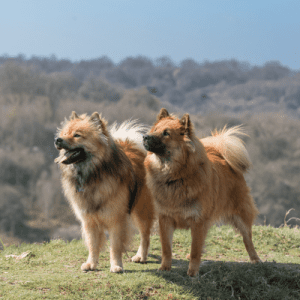
What Is The History Of The Eurasier Breed?
The Eurasier breed is believed to have been developed in the 1960s in Germany by Franz-Josef Van der, followed by Charmaine and Peter Scheerer. The intention was to create a dog that combined the best characteristics of two popular breeds – the Chow Chow and the Wolfspitz (Keeshond).
The Chow Chow was chosen for its independent, loyal and reserved nature, while the Wolfspitz was selected for its friendly temperament and ability to get along well with children. Additional crossings were made with the Samoyed and Giant Schnauzer from these two foundation dogs to help improve certain desired traits such as size, coat type and color.
The Eurasier breed grew in popularity throughout Europe and was officially recognized by the Federation Cynologique Internationale (FCI) in 1971. In recent years, the breed has also gained popularity in North America and is now recognized by several regional kennel clubs.
What Does An Easier Look like?
The Eurasier dog breed has a thick, double coat that can be either wavy or straight. The most common colors are black and tan, but they can also be fawn, Wolf sable, or red. The coat is medium to long in length, and they shed seasonally. Grooming is required to keep their coat healthy and free of mats.
How Big Is An Adult Eurasier?
The average adult Eurasier male weighs between 50 and 70 pounds, while the average adult female Eurasier weighs between 40 and 55 pounds. However, there is some variation in size within the breed, so some individuals may be larger or smaller than these averages. Males typically stand 21 to 24 inches tall at the shoulder, while females usually stand 19 to 22 inches tall. Again, the breed has some variation, so individual dogs may be taller or shorter than these averages. In general, Eurasiers are medium-sized dogs with a fairly rectangular build. They are not particularly long-legged or short-legged for their height, but they have relatively long tails that they often hold curled over their backs when relaxed.
Are There Other Dog Breeds Related To The Eurasier?
Several dog breeds are related to the Eurasier, including the Chow Chow, Samoyed, Shiba Inu, Akita Inu, Alaskan Malamute, Siberian Husky, Chinese Shar-Pei, and Tibetan Mastiff. These breeds share a number of common features, including thick fur coats and a tendency to be independent and loyal. However, each breed has its unique set of characteristics that make it distinct from the others.
What Is The Life Expectancy Of An Eurasier?
The lifespan of a Eurasier can vary depending on several factors, such as diet, exercise, and overall health. However, on average, a healthy Eurasier can expect to live between 10 and 12 years. Some individual dogs have been known to live even longer, into their early 20s. Your Eurasier can enjoy a long and healthy life with proper care and attention.
Can An Eurasier Be Trained?
An Eurasier can be trained to do various things, from simple commands such as sit and stay to more complex tasks such as herding livestock or performing tricks. The key to successfully training an Eurasier is to start early, be consistent with your commands, and use positive reinforcement techniques such as treats or praise. With patience and perseverance, you can teach your Eurasier just about anything!
What Are Some Interesting Facts About An Eurasier?
-The Eurasier is a relatively new dog breed, developed in the 1960s.
-The Eurasier was created by crossing the Chow Chow, the Wolfspitz, and the Samoyed.
-The Eurasier is considered an ideal family pet, as they are known for being gentle, loyal, and protective of their loved ones.
-Eurasiers are typically very independent dogs and are not typically needy or clingy.
-Eurasiers have a reputation for being one of the most intelligent dog breeds and are often easy to train.
-Despite their Chow Chow ancestry, Eurasiers do not typically shed much hair.
-Eurasiers are medium-sized dogs, typically weighing between 35 and 60 pounds.
How Does An Eurasier Interact With People?
Eurasiers are very loving and loyal dogs that enjoy being around people. They are known for their friendly dispositions and make great family pets. Eurasiers typically get along well with other animals, including other dogs, making them ideal companions for active households. While they may be initially shy around strangers, they warm up quickly and enjoy being the center of attention. Eurasiers enjoy spending time with their families, playing fetch, and going on walks. They can be very outgoing dogs that enjoy meeting new people and exploring new places with proper socialization.
